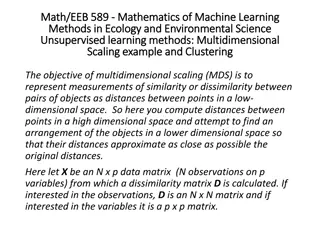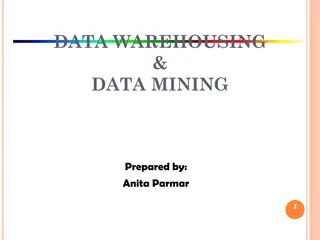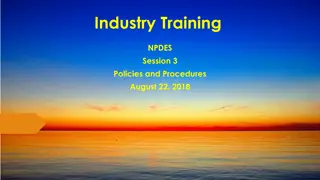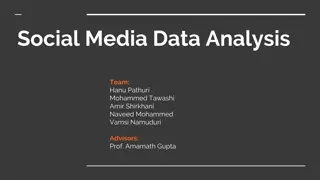Scaling Big Data Mining Infrastructure: The Twitter Experience
The paper explores the challenges faced by Twitter in scaling its analytics infrastructure to handle massive amounts of data. It discusses the importance of schemas, data cleaning, and formulating precise analytical questions. Methods used for logging and structuring log messages are also highlighted. The authors share their experiences in dealing with the heterogeneity of components and integrating processes to build a robust data analytics platform at Twitter.
Uploaded on Oct 05, 2024 | 1 Views
Download Presentation

Please find below an Image/Link to download the presentation.
The content on the website is provided AS IS for your information and personal use only. It may not be sold, licensed, or shared on other websites without obtaining consent from the author.If you encounter any issues during the download, it is possible that the publisher has removed the file from their server.
You are allowed to download the files provided on this website for personal or commercial use, subject to the condition that they are used lawfully. All files are the property of their respective owners.
The content on the website is provided AS IS for your information and personal use only. It may not be sold, licensed, or shared on other websites without obtaining consent from the author.
E N D
Presentation Transcript
Scaling Big Data Mining Infrastructure: The Twitter Experience By: Jimmy Lin & Dmitriy Ryaboy
2 Outline: Introduction The problem! The big data mining cycle where to find the data? conclusion future Exploration
3 Introduction The analytics platform at Twitter has experienced tremendous growth over the past few years in terms of size, complexity, number of users, and variety of use cases. The number of employees at twitter has change since 2010 working on thousands of Hadoop nodes across multiple datacenters! Each day, 100 TB of raw data ingested into twitter s main Hadoop data warehouse. In this paper; they shared their experience in scaling twitter s analytics infrastructure.
4 The problem Schemas are important in helping data scientist understand big data, but schemas alone not enough. Major challenge in building data-analytics platforms comes from heterogeneity of the component and their integration process. (i.e. impedance mismatch at the interfaces).
5 The problem Where s the data? What s in this dataset? Clean the data ! Gathering Moving organizing
6 The problem Sample questions to help scientist in precisely formulate the problem: When do users typically log in and out? How frequently? What features of the product do they use? Do different groups of users behave differently? Do these activities correlate with engagement? What network features correlate with activity? How do activity profiles of users change over time?
7 Methods 1- Log directly into a database ! Don t use MySQL as a Log !! - Workload mismatch - Scaling challenges - Overkill with logging ! - Schema changes
8 Methods 2- Use Scribe ! But it solves log transport only !
9 Methods How should log messages be structured? Plain-text log messages vs. JSON An actual Java regular expression used to parse log messages at Twitter 2010
10 3- Use JSON to structure the data This should be a list Is this a null or a string? Problems?? -No fixed schemas -unconstrained even if standardized parsing is used What keys? What values?
11 4- Structured Representation? Use Thrift ! - Efficient serialization of all logged messages - Sane path for scheme migration - separation between logical & physical data representation ! - They developed Elephant Bird tools that hooks into the Thrift serialization compiler to automatically generate record readers, record writers, and code for both Hadoop, Pig, and other tools.
12 Scheme is not enough! We need a data discovery service ! where s the data? How do I read it? Who produce it? Who consume it? When was it last generated?
13 Where to find the data ? Old way: hard coded partitioning scheme, path, format New way (HCatalog project in Apache incubator) : Nice UI for browsing Same loader each time Filters are pushed into the loader No need to understand partitioning scheme
14 In Twitter : They built tools around HCatolog to make it more suitable for their needs. They plan on further development for integrating schemes
15 Scalable machine Learning Not an easy task Mahout: a popular toolkit for large-scale machine learning and data mining tasks. Twitter & Mahout: Some Mahout components are designed to run on a single machine, and other parts that scale to massive datasets using Hadoop. Requires adaptors on both ends
16 Production consideration Dependency management, Scheduling. Resource allocation, Monitoring, Error reporting, Alerting They need : 1- Seamless scaling 2-integration with production workflows Pig scripts MADLib SystemML
17 conclusion Under explored questions : 1. visualization is important for Big data mining. 2. Real time interactions with large datasets to enable fast experimentations.
18 conclusion The goal is achieving the right balance between: speed of developments, ease of analytics, flexibility, scalability and robustness. How to provide useful tools while staying out of the way of developers is a difficult challenge. As the organization grows; the analytical infrastructure will evolve!
19 Future Exploration Are there prototypical evolutionary stages that data centric organizations go through? how do we smoothly provide technology support that will help organizations grow and transition from stage to stage?
20 Thank you Bayan Almuqhim, 433920231 19, Mar, 2014























